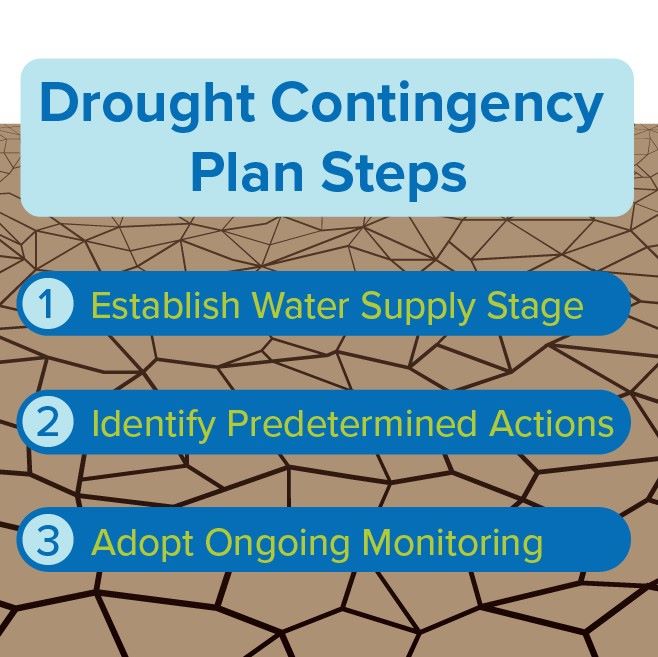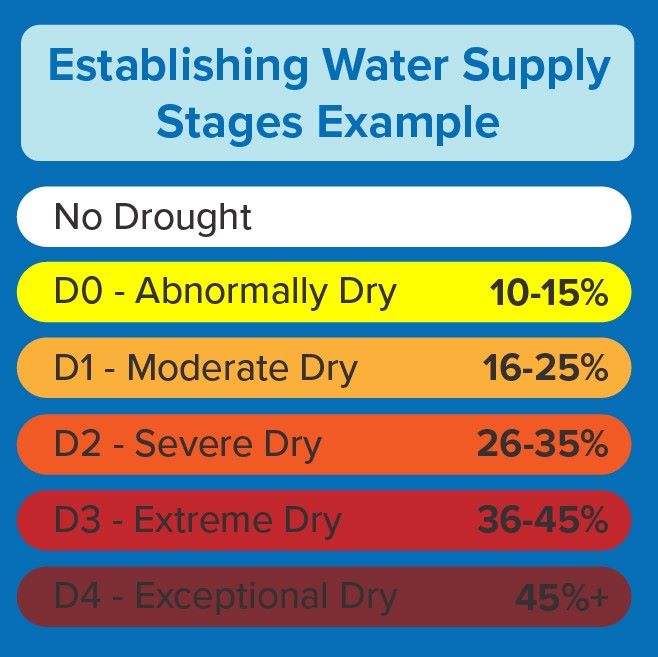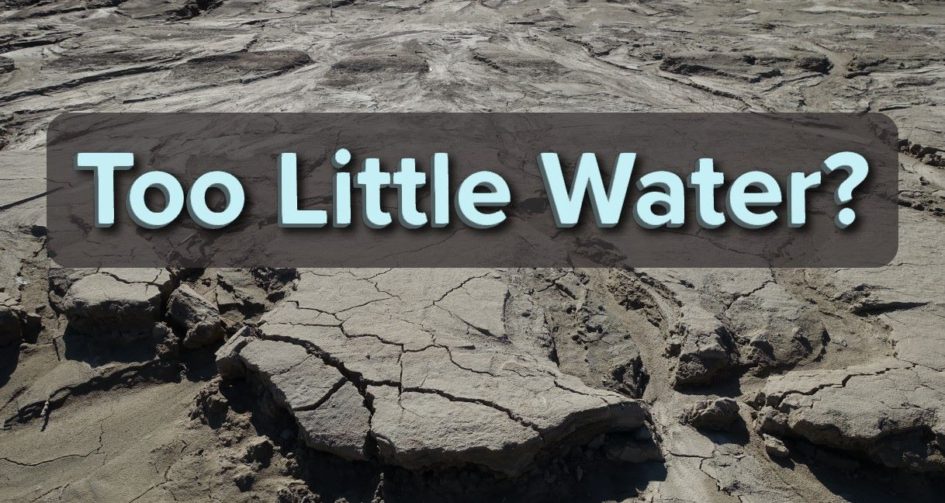As of the first week of September, more than 30% of the United States is experiencing drought conditions according to the National Integrated Drought Information System. The need for drought contingency planning is apparent considering the megadrought occurring in the western part of the United States. It highlights the importance of long-term planning and responding early to drought conditions. Drought contingency plans generally involve three steps, listed in the graphic below. 
Establish Water Supply Stages to Convey Severity
The establishment of water supply stages provides distinct parameters that indicate the level of severity of drought conditions. These stages may describe the percentage of water supply that is deficient. Each water system should consider their respective and unique conditions.
Marie Owens, AE2S Client Program Leader, recommends that water systems choose the number of stages the water system will utilize. The stages should represent a continuum from no drought to the most severe level of drought that could be experienced by the system.

“Assigning a specific description and deficiency percentage, numbers, and color for each stage can help the public understand the level of severity when the water system announces a change to the water supply stage. This can be illustrated in several ways, such as color-coded maps or other graphics,” explains Owens. “You want to have enough stages that you can effectively communicate the severity but not so many that it becomes difficult to differentiate between the stages.”
Identify Predetermined Actions Associated with Each Stage
Once the stages are established and parameters set, the predetermined actions that will be requested of the water system, city, and customers can be identified. The actions that align with each water supply stage are important because they are the steps that will help mitigate the effects of drought through conservation and other measures. Owens says water systems need to consider the following when identifying actions associated with each water supply stage:
Appropriateness: Tie the action to the quantity of water that needs to be saved. The more severe drought stages require greater conservation measures, and less serious stages should have lower conservation requirements.
Actionable: Select actions that are within a given audience’s authority to implement. For instance, only the water system or utility has the authority to switch from groundwater to surface water, but property owners can limit lawn watering to certain days.
Communicable: Each action should be easily understood and able to be communicated in a timely manner to the audience that needs to act.
Fair: Conservation efforts should be requested equally across populations in the service area, not one area of town versus another. In addition, let residents know what the water system is doing to conserve so it is clear everyone is being asked to contribute to solving the problem.
Sustainable: How long can the requested action continue in an extended drought event? For example, it’s not feasible to stop flushing toilets altogether. Though in extreme cases water customers may be encouraged to wash dishes and clothes on certain days, take short showers instead of baths, or flush solids instead of liquids.
These considerations are important because the water conservation actions requested need to be well thought out and explained to the public. “It can be a complex concept to explain why water conservation is necessary despite recent heavy rain or snowfall,” says Owens. “It is possible to experience too much water and not enough in the same year. Unfortunately, it’s not uncommon.”
Adopt Ongoing Monitoring Procedures
When the water supply stages and water conservation actions are identified, ongoing monitoring procedures should be adopted to ensure mitigation efforts can begin as soon as drought conditions are predicted. A live and dynamic drought monitoring model will collect data so trends can be identified.
The City of Bozeman, Montana utilizes a Water Supply Optimization and Management Tool that integrates physical hydrologic yield, legal availability, infrastructure constraints, and system-wide demand to better define reliable supply and demand each month. The tool also forecasts deficits under varying hydrologic and population growth scenarios.
AE2S and Jacobs developed the Water Supply Optimization and Management Tool which has provided clear and defensible evidence that increasing reservoir storage or developing new storage capacity is a simple, near-term solution. Longer-term advice recommended by the Water Supply Optimization and Management Tool include developing a completely new water source out of the Gallatin basin, as well as exploring the feasibility of aquifer storage and recovery.
“Leveraging real-time data via dynamic models and tools empowers water providers with early warnings, optimized supply sources, and sustainable water management,” says Kellen Grubb, AE2S Project Manager. “Furthermore, clean and concise reporting on the backend fosters customer awareness, engagement, and coordinated responses to help mitigate the negative effects of droughts.”
Funding Drought Projects
Access to adequate and safe water supplies is fundamental to the health and economy of communities. Though the development of a drought contingency plan may seem labor-intensive on the front end, having a playbook that outlines a water system’s parameters for drought levels and the corresponding actions means time saved when drought conditions emerge.
The Bureau of Reclamation offers WaterSMART grant funding to states in the western half of the United States. Since 2021, the Bureau has funded 539 projects with $239.8 million of WaterSMART funding.
“There’s tremendous opportunity for funding through the WaterSMART program, which has over $1 billion available to support water supply and drought resiliency in the western U.S. Just this month, WaterSMART announced open application periods to access $90 million for Drought Resilience Projects, Planning, and Design grants,” says Abby Ritz, AE2S Nexus Funding Programs Specialist.
If you have questions about the Bureau of Reclamation or other funding opportunities, contact Abby.Ritz@ae2s.om. For general questions about the development of a drought contingency plan, contact Marie.Owens@ae2s.com.

